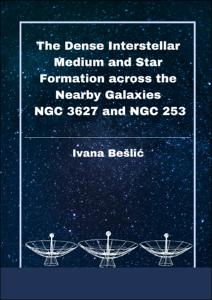The dense interstellar medium and star formation across the nearby galaxies NGC 3627 and NGC 253

The dense interstellar medium and star formation across the nearby galaxies NGC 3627 and NGC 253

| dc.contributor.advisor | Bigiel, Frank | |
| dc.contributor.author | Bešlić, Ivana | |
| dc.date.accessioned | 2023-10-11T09:11:23Z | |
| dc.date.available | 2023-10-11T09:11:23Z | |
| dc.date.issued | 11.10.2023 | |
| dc.identifier.uri | https://hdl.handle.net/20.500.11811/11094 | |
| dc.description.abstract | The star formation process is an essential aspect of galaxy evolution. Observations of star-forming regions from sub-pc to kpc scales revealed a tight correlation between star formation and the emission of high-critical density molecules (HCN, HNC and HCO+). However, it is still unclear whether stars can form in regions where gas is overall denser or whether this gas is notably more efficient at producing stars. The missing piece in the star formation puzzle lies in understanding the properties of dense molecular gas at giant molecular cloud scales. Compared to the CO emission, high-critical density lines are faint, making them difficult to detect and approaching the sensitivity limits of current observing facilities. Despite recent major efforts to map molecular emission traced by the CO molecule at cloud scales, we still lack an equivalent study of high-critical molecular lines at these scales, covering a set of environments across nearby galaxies.
In this doctoral thesis, we expand the previous efforts in recent extragalactic studies to bridge the gap between our knowledge of star formation in the Milky Way and across unresolved systems at high redshifts. This study presents the first attempt to constrain the role of dense molecular gas at a few hundred pc and its relation to star formation across two nearby galaxies, NGC 3627 and NGC 253, using observations of high-critical density molecular lines within the 3 mm regime obtained by NOEMA and ALMA. The major results of this doctoral thesis are that the intensity ratio of high-critical density lines (i.e. HCN) to the CO(2-1) appears sensitive to molecular cloud surface density changes, which makes them an excellent tool for constraining the density contrast. In studying the star formation efficiency of dense molecular gas, we found that environmental conditions play a crucial role. For example, the centres of NGC 3627 and NGC 253 contain the largest amount of dense molecular gas, yet their star formation efficiency is significantly reduced, whereas we found more efficient gas in other regions of these galaxies, such as in the bar ends, ring and spiral arms. Our results could be a result of the kinematics of dense molecular gas playing a critical role in setting the ability of gas to form stars. The complex kinematics observed in the centre and bar of NGC 253 show that it can significantly decrease this dense gas star formation efficiency while converging dense gas flows can further enhance the star formation process, as seen in the bar ends of NGC 3627. The results presented in this doctoral thesis further support the importance of understanding the properties of dense molecular gas in nearby galaxies. Together with the turbulent theory of star formation, the emission of these high-critical density lines relative to the mean gas densities and the role of the environment are essential drivers of local star formation at scales of molecular clouds. This work outlines the importance of obtaining a clearer picture of the dense interstellar medium, which is the major contributor to the baryon cycle of galaxies that ultimately dominates their cosmic evolution. | en |
| dc.language.iso | eng | |
| dc.rights | In Copyright | |
| dc.rights.uri | http://rightsstatements.org/vocab/InC/1.0/ | |
| dc.subject | Interstellar medium | |
| dc.subject | Molecules | |
| dc.subject | Galaxies | |
| dc.subject | Star formation | |
| dc.subject.ddc | 520 Astronomie, Kartografie | |
| dc.subject.ddc | 530 Physik | |
| dc.title | The dense interstellar medium and star formation across the nearby galaxies NGC 3627 and NGC 253 | |
| dc.type | Dissertation oder Habilitation | |
| dc.publisher.name | Universitäts- und Landesbibliothek Bonn | |
| dc.publisher.location | Bonn | |
| dc.rights.accessRights | openAccess | |
| dc.identifier.urn | https://nbn-resolving.org/urn:nbn:de:hbz:5-72667 | |
| dc.relation.doi | https://doi.org/10.1093/mnras/stab1776 | |
| ulbbn.pubtype | Erstveröffentlichung | |
| ulbbnediss.affiliation.name | Rheinische Friedrich-Wilhelms-Universität Bonn | |
| ulbbnediss.affiliation.location | Bonn | |
| ulbbnediss.thesis.level | Dissertation | |
| ulbbnediss.dissID | 7266 | |
| ulbbnediss.date.accepted | 18.10.2022 | |
| ulbbnediss.institute | Mathematisch-Naturwissenschaftliche Fakultät : Fachgruppe Physik/Astronomie / Argelander-Institut für Astronomie (AIfA) | |
| ulbbnediss.fakultaet | Mathematisch-Naturwissenschaftliche Fakultät | |
| dc.contributor.coReferee | Menten, Karl | |
| ulbbnediss.contributor.orcid | https://orcid.org/0000-0003-0583-7363 |
Files in this item
This item appears in the following Collection(s)
-
E-Dissertationen (4137)




